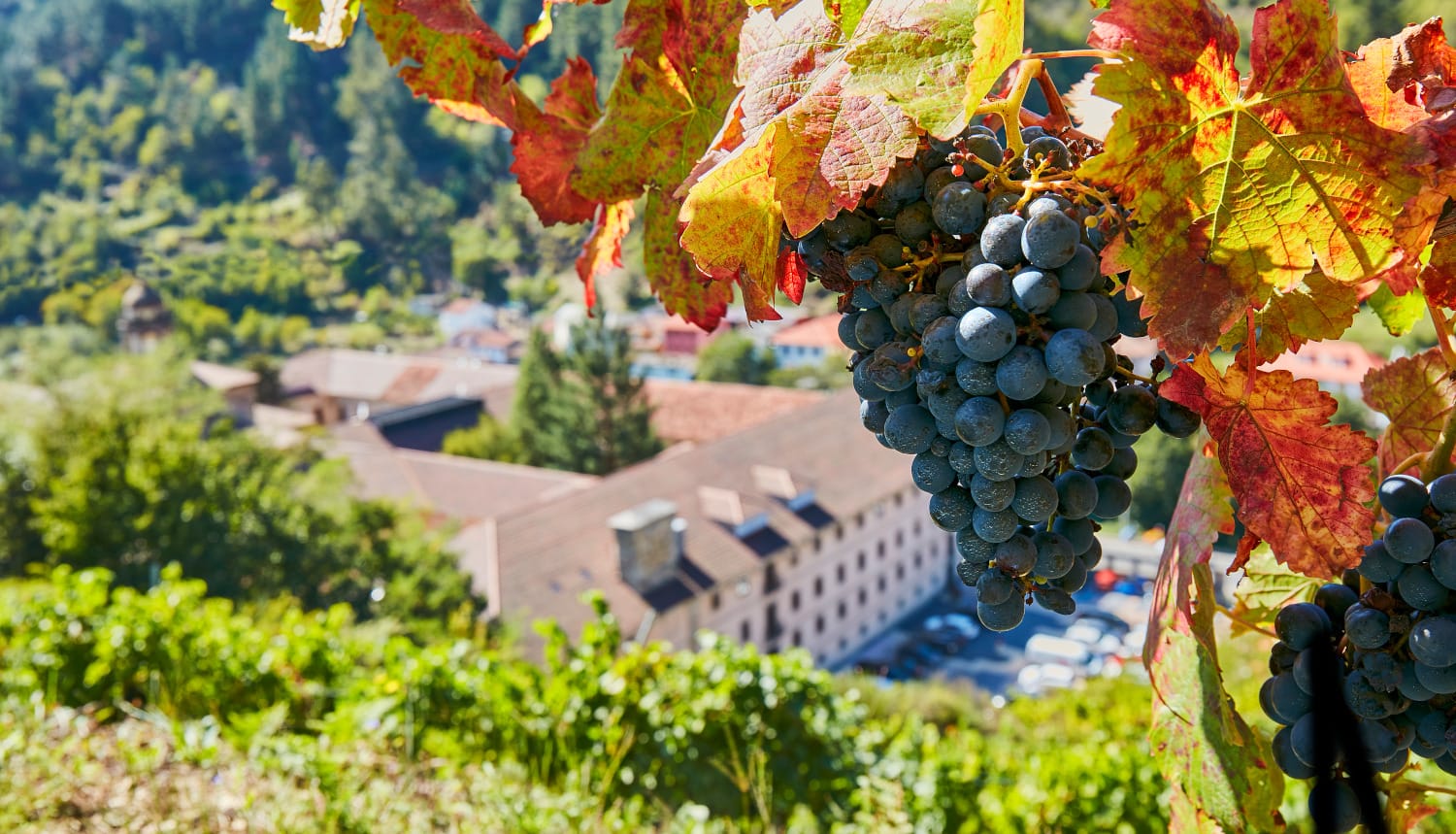Back The 10 best things to see and do in Cangas del Narcea

The 10 most interesting things to see and do in Cangas del Narcea
If Robín de los Bosques had known Cangas del Narcea, he would never have wanted to leave Asturias, because this land is a real vegetal dream where you can find one of the most extensive, well-kept and representative wooded areas of the Atlantic forest in Europe.
Cangas del Narcea, which looks more like a miniature continent than a council, is not only an exquisite forest spot where the Cantabrian brown bear roams freely, but it is also an authentic reserve of medieval, Renaissance, Baroque and contemporary architecture; a place where you can get a taste for gunpowder and good wine, or where you can feel like a pilgrim climbing up to the Santuario del Acebo (Sanctuary of the Holly Tree).
Where you will discover dreamy villages of bucolic presence, and ancient traditions such as that of the ferreiros or the black pottery of Ḷḷamas del Mouro. Where you will see monasteries of imposing history and architecture such as Courias, or where you can stroll through one of the most remarkable historical and monumental towns in Asturias, Cangas del Narcea.
There are many Cangas and they are all characterised by the authenticity and spectacular landscapes, and the spontaneity and kindness of its people.
That's why we propose a different kind of trip so that you can experience the 10 best things to see and do in Cangas del Narcea at your own pace.
A leisurely stroll through one of the most remarkable historical and monumental towns in Asturias.
The first thing that will strike you about the town of Cangas del Narcea and capital of this immense council is the lively atmosphere that its streets exude, at any time of the day and even at night. Cangas is a welcoming place where you will never feel like a stranger. Strolling through its streets and discovering its historic quarter is a real delight.
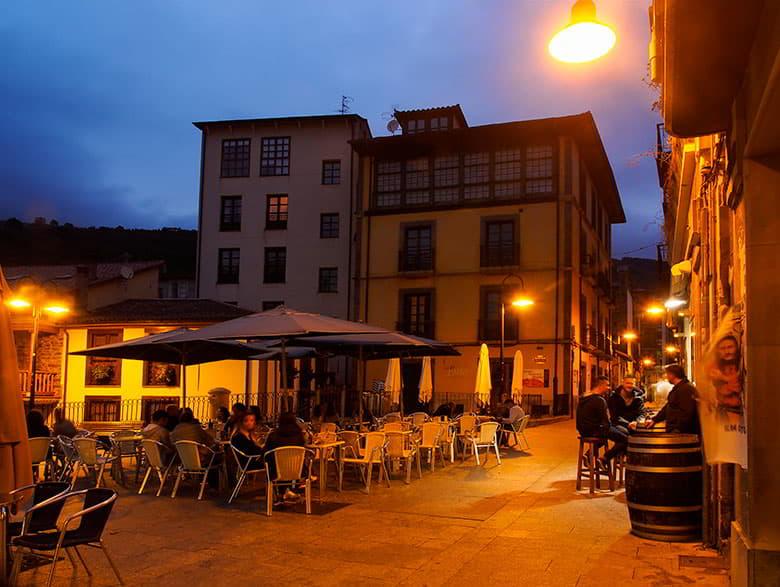
Cangas del Narcea is one of the towns with the largest number of palaces and emblazoned houses in its urban heart in the whole of Asturias, and to contemplate them is to contemplate the history of this part of south-western Asturias. You will see how the main houses were built in the upper part of the town, while the town grew in the lower part, and it is precisely in this area where you will find old quarters such as Entrambasaguas - where the chapel of Carmen is located - or Cascarín.
Walking along Calle Mayor, or Calle la Fuente, Calle de Arrastraculos or Sol Mercáu, the Plaza de la Oliva with its Basilica of Santa María Magdalena, and so many other places will give you the true pulse of life in Cangas, a quiet but lively life where you can't miss the vermouth, or a good Cangas wine, or coffee and conversation in the evening, and of course dinner and drinks, without forgetting to wander around its charming shops in search of local products or any other detail you might fancy.
You will also find a Monument to the Miner, which presides over one of the town's lively squares, and which bears witness to the mining activity in the area, especially coal mining in the last century, although the council of Cangas del Narcea also preserves traces of gold mining in Roman times.
And, of course, don't forget to take a look at its bridges: you can see six at a glance, of all ages and designs, and you will discover that Cangas is the river town in Asturias with the most bridges and the most curiosities, because, for example, its suspension bridge - the work of the Cangas architect José Gómez del Collado - was the first civil work where chicken wire was used?
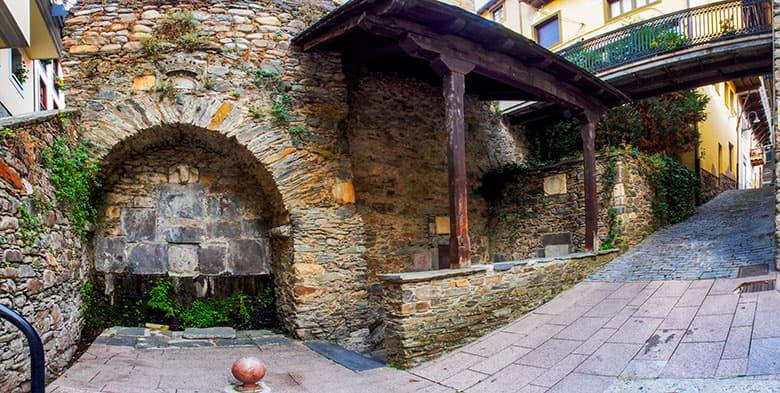
In short, on your stroll through Cangas you will feel that locals and foreigners merge in its streets in delicious and unforgettable moments...
The Monastery of Corias, the Escorial of Asturias
The Monastery of Corias, now an emblematic accommodation in the Parador network, is visually striking and powerful. Just three kilometres from the town of Cantabria is the village of Corias, and its monastery is a place that impresses you with its grandeur and peace in the middle of a narrow valley bathed by the Narcea river.
The monastery, popularly known as the "Asturian Escorialín", is surrounded by vineyards, and the sheer size of its proportions and surface area - it covers twenty-six thousand square metres - give it a special atmosphere, which you will experience in situ when you visit its cloisters, its church and learn about its intense history through the guided tours organised by the Parador itself.

The Monastery of San Juan Bautista de Corias, from the Middle Ages to the present day, has marked the evolution of life in Cantabria. First the Benedictines and then the Dominicans made this monastery in the heart of western Asturias one of the most important centres of culture and teaching in Spain, as well as promoting the cultivation of wine, so deeply rooted in the area due to the mild microclimate of this part of Asturias.
In the Parador Monasterio de Corias the monastic spirit is clearly perceived, and in areas such as the library it is palpable, because the setting and the atmosphere are enveloping.
Munieḷḷos, the king of Asturian oak groves
Cangas del Narcea is synonymous with forests, not in vain within its boundaries is the largest oak forest in Spain and one of the best preserved in Europe, MuniellosItopens in a new tab, with 55 km2 of mountains, valleys, rivers and forests with a lot of history and tradition that, since 1964, have remained virtually untouched. Crossing it, to access the lagoons of the Pico de la Candanosa, is a highly recommended experience for hiking enthusiasts, currently restricted to a maximum of 20 people per day.
The route to Munieḷḷos will put you on the way to unique landmarks such as the medieval bridge of La Riela, or the village of Mual, which looks splendid at the foot of the forest of the same name and through which runs a more than interesting hiking route.
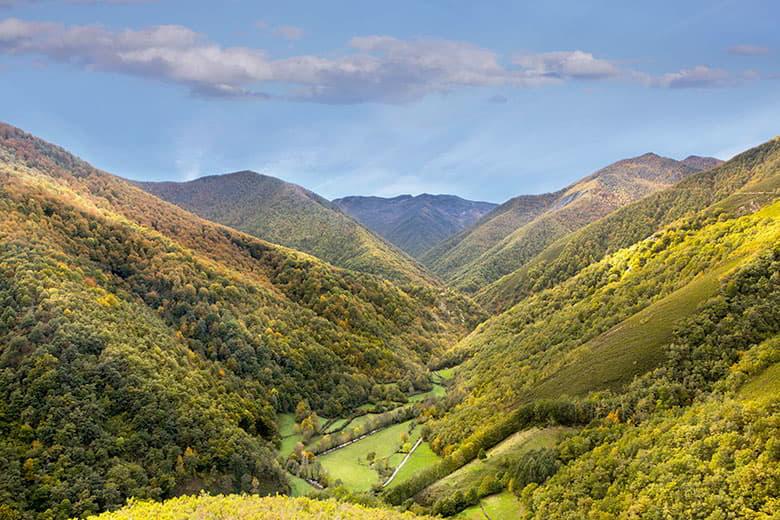
As you advance along the path and the forest mass comes into view, the sensation is one of immense vegetation, and it is precisely this immense vegetation that is the best ecosystem for the life of the Cantabrian brown bear. Here this unique species has its perfect refuge, and this makes Cangas del Narcea one of the most important bear-producing areas on the Cantabrian coast.
To get a closer look at the life of this plant-eater, we recommend a large dose of patience and respect for the environment, and of course to go to one of the bear viewing points provided for this purpose to observe the native fauna and more specifically the brown bear.
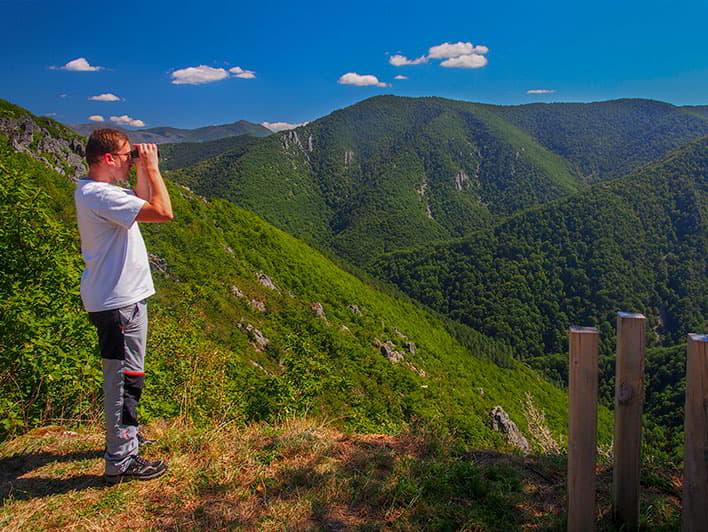
For example, you will find one of the most beautiful on the ascent to the Connio pass, another of the panoramic routes in Cangas del Narcea. You may not see any bears, but just contemplating the scenery is extremely gratifying.
Cueto de Arbas, a fascinating Nature Reserve
Nature constantly surrounds you in Cangas del Narcea, not in vain the municipality is part of the Biosphere Reserve known as Fuentes del Narcea, Degaña and Ibias.
There are many landscapes of great purity that extend through its almost infinite territory and among them is Cueto de Arbas, one of the most emblematic mountains in Cangas del Narcea, and at the foot of which is a glacial lake of spectacular beauty.

The Cueto de Arbas is a beautiful route which you reach by going up the Brañas/Leitariegos pass - also with beautiful views and where you will find the Brañas d'Arriba bear lookout point. Before arriving you cross the village of Leitariegos which, at 1525 metres, is one of the highest in Asturias.
You will undoubtedly be in front of one of the most incredible landscapes in all of Cangas del Narcea.
Spain's most unique heroic viticulture
A walk around the council of Cangas del Narcea will lead you to a discovery that, at first sight, will come as a shock considering that you are in Asturias, and that is that where you would expect to find orchards you will find vineyards.
The benign microclimate of the south-west of Asturias has favoured a winemaking tradition that has meant that wine has been made in Cangas del Narcea houses since time immemorial instead of cider.

This tradition has engendered a widespread love and vocation for the vineyards, which in the last twenty years has turned Cangas into an emerging wine-producing destination with its own PDO Vino de Cangas. And how could it be otherwise - given the playful and expansive nature of the people of Cangas - this activity is the protagonist of the other great festive event of the year: La Vendimia, a festival that this year is held between 10 and 13 October, when the grape harvest begins. Wine tastings, visits to wineries and vineyards, children's grape harvest and a market are some of the most outstanding activities that fill not only the town with atmosphere, but also the different wineries and vineyards around the capital of Cantabria.
With the added attraction that some of these wineries and vineyards can be visited, and that in Cangas itself there is a Wine Museum, with a two-kilometre walk along the banks of the river...
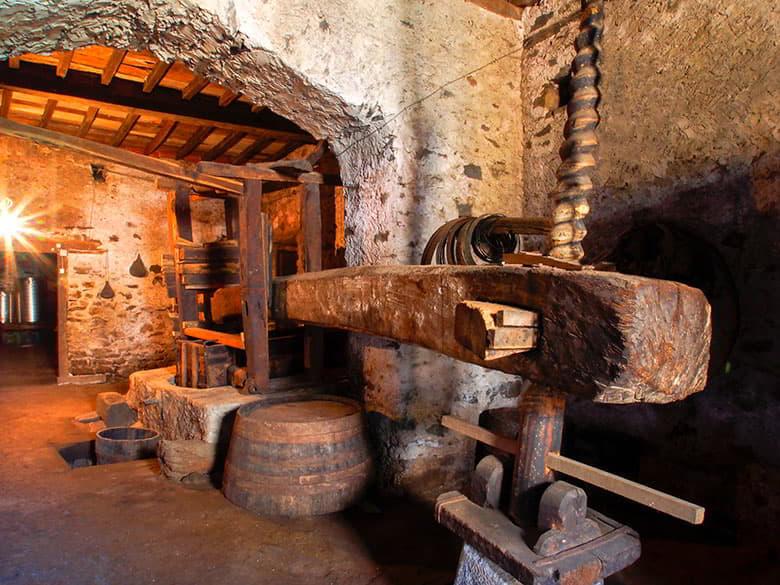
When you take a look at the landscape, your retina will shudder at the sight of the vineyards hanging from the mountainside, as if they were mountaineers trying to reach the summit. You'll see old vines and new vineyards against the deep green of the mountains. You will see palaces perched on cliffs, with their stylised poplars, like a Tuscan landscape. You will see a monastery with vineyards... And you will realise the heroic nature of this unique viticulture.
A continuous succession of charming villages
If nature is prodigious in Cangas del Narcea, its many villages are not to be outdone. In this itinerary we propose you to enter the Cibea River Valley, one of the many valleys that make up the landscape of Cangas del Narcea, and enjoy the contemplation of villages such as Ḷḷamera, Sonande or Carbaḷḷo, to name but a few examples.
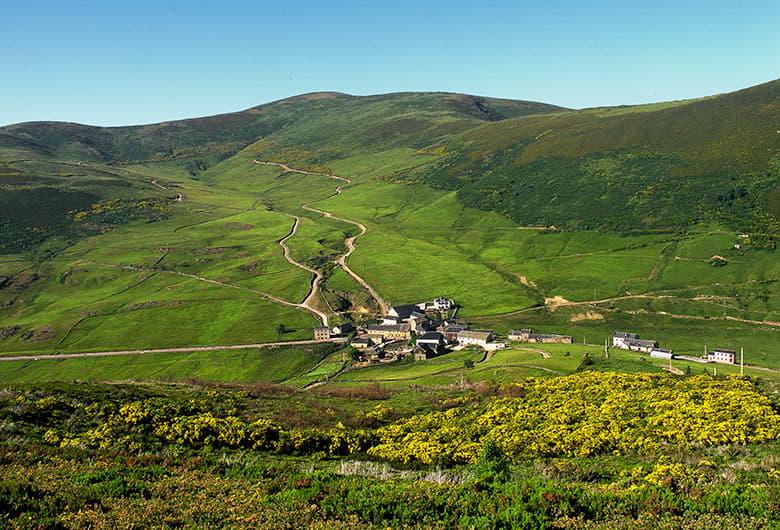
In all of them you will contemplate rural life in its most authentic expression, as well as enjoying the hospitality of its people, and the important historical and ethnographic heritage that, in the form of palaces and emblazoned houses, granaries and granaries, mallets and draught mills, or imposing farmhouses, characterise the physiognomy of most of the almost three hundred villages in the largest council of Asturias.
Bisuyu, the literary village
Just seventeen kilometres from the town of Cangas del Narcea, and on the border with the council of Allande, is Bisuyu, one of the most beautiful and charismatic villages in the area.
Bisuyu preserves intact its old charm and the purity of the typical constructions of western Asturias. And it also conserves in excellent condition its mallet, where in another era the local ironworkers made their pieces, given that in Bisuyu there was an important tradition of forging, with twenty-six active workshops. This mallet is located in idyllic surroundings and you will be able to see for yourself if you take a guided tour.

In short, this charming village perched on a hill can boast many things, one of the most notable of which is that it is the birthplace of the brilliant and famous playwright Alejandro Casona.
Casona is omnipresent in the village where he was born, not only because of the widespread devotion to him by his fellow villagers, but also because it has an Alejandro Casona Visitor Reception Centre located in the old schools, and because all of Bisuyu is full of references to the famous writer, from his birthplace, which has an inscription on the outside, to the parish church of San Martín, which also has a plaque-tribute to the playwright in its surroundings.

The memory of the writer is so vivid that every year one of his works is performed in the streets of his village... And Bisuyu has very special corners, as if they were literary, as if they were taken from one of Casona's own works.
One of these corners leads us to the chapel of Las Veigas and another to the chapel of La Magdalena, which must be one of the most perched chapels in the whole of Asturias, as it is located at the top of a crag that dominates the whole valley.
A place that "smells" of gunpowder: El Prau El Molín
When wandering around Cangas del Narcea, you should not miss a leisurely stroll through the Prau El Molín, the epicentre of the famous "Descarga", which has been organised by the Sociedad de Artesanos de Cangas del Narcea for over a hundred years and is held every year on 16th July, the feast of the Virgen del Carmen.
When the evening of Carmen's Day falls, the sky of Cangas is transformed into an immense stain of gunpowder thanks to the massive release of voladores in honour of the Virgin, which are launched uninterruptedly into the sky for seven or eight minutes. It is a unique fiesta in Spain and if you happen to be there it is well worth enjoying the passion with which the people of Cantabria live these days and which fills every corner of the town, day and night.
But, even if it is not the festival of El Carmen, the Prau El Molín, with its monument to the shooters of La Descarga, and with its splendid views of the chapel of El Carmen and the Roman Bridge, with the murmur of the waters of the Luiña and the Narcea as they meet there, and with its intense green and its fluvial pool, will transport you to the day of La Descarga itself, you will even feel the smell of gunpowder...
The black pottery of Ḷḷamas del Mouro, a living tradition
Cangas del Narcea is a territory where the ancestral comes to you. Old traditions are sometimes maintained thanks to the effort and perseverance of a few. This is the case of the family of Jesús Rodríguez, the only one that continues to make black pottery in Ḷḷamas del Mouro.
In this way, this small village located 22 kilometres from the town of Cantabria is on the world map thanks to its original, unique, resistant and perfect ceramic pieces for the preservation of foodstuffs.
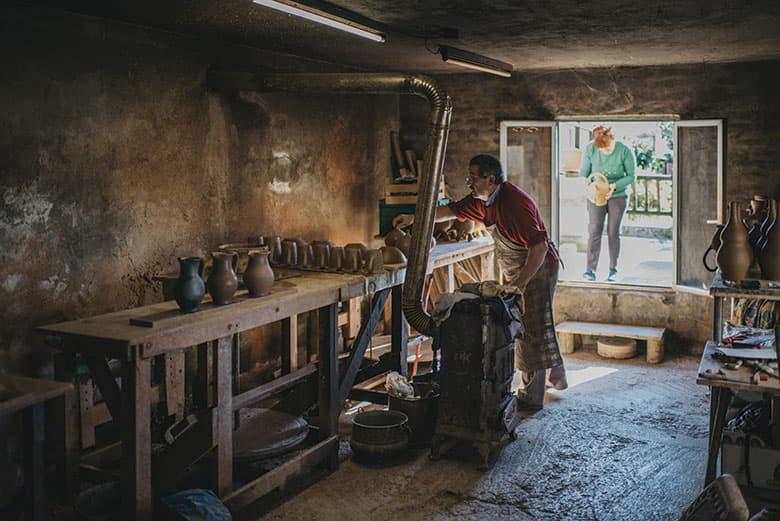
The Rodríguez family, with a workshop and shop in this village, is the architect of the fact that Ḷḷamas del Mouro is the only village in western Asturias where this tradition is kept alive.
The serene influence of the Acebo Sanctuary
The Sanctuary of L'Acebu is one of the Marian Sanctuaries of Asturias. For this reason the trickle of pilgrims is constant throughout the year, and as María Alvarez - who had a souvenir stall there for more than fifty years - commented years ago, "they come from all over Asturias, especially from the west, and also from other countries in Europe and America".
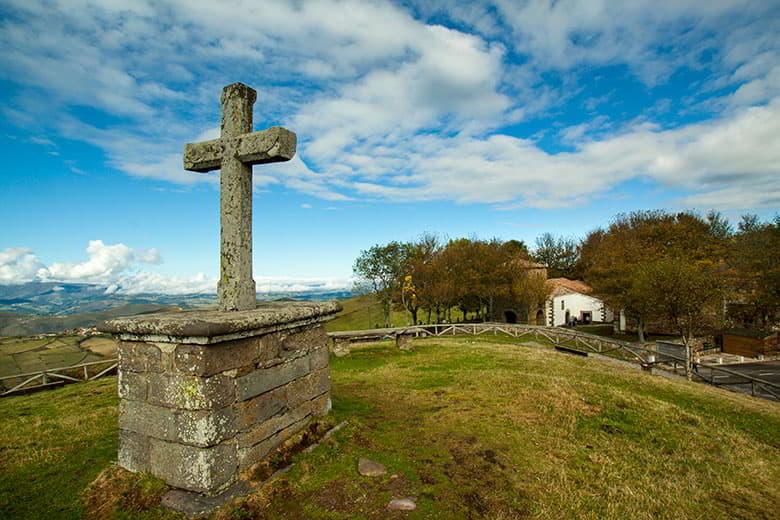
María herself recalls a popular saying that goes "from L'Acebu to the sky and a hole for a candle", and the peace in this Sanctuary is breathable, and the panoramic views from the Alto de L'Acebu will leave you open-mouthed. It will be like having a 360-degree view of the entire council of Cangas del Narcea, which is impressive not only for its beauty but also for its immensity.
The visit to the Sanctuary of L'Acebu, not far from the town of Cangas del Narcea, is a pleasant excursion that you can do on foot, by car, by motorbike or by any other means that you find pleasant...
The tranquillity of the Sanctuary and its pleasant surroundings for a stroll, or simply to take a break and have a drink, will make you want to come back. L'Acebu will surely stay with you as one of the idyllic memories of your trip to Canguez.
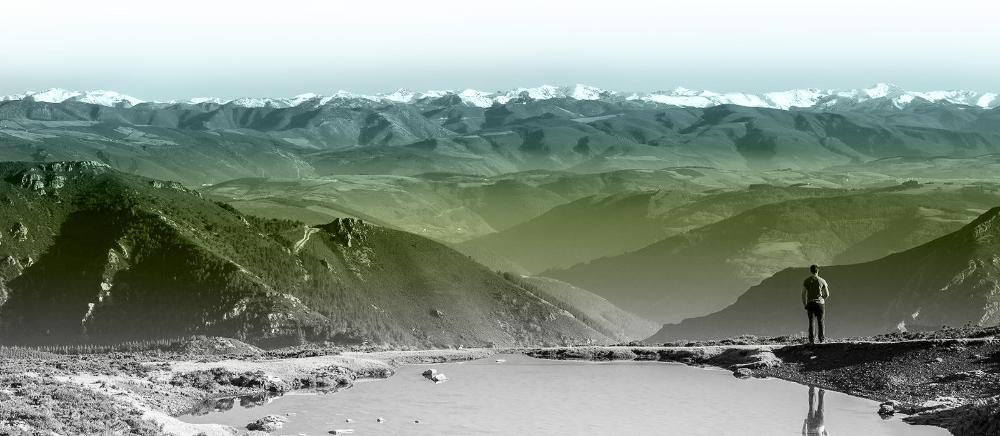
Subscribe to our newsletter and take advantage of offers, discounts, and news
Subscribe

